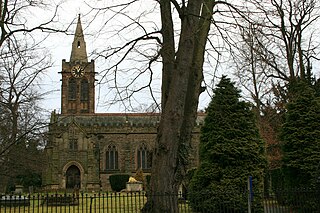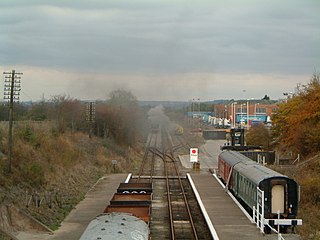
Worksop is a market town in the Bassetlaw District in Nottinghamshire, England. It is located 15 miles (24 km) south of Doncaster, 15 miles (24 km) south-east of Sheffield and 24 miles (39 km) north of Nottingham. Located close to Nottinghamshire's borders with South Yorkshire and Derbyshire, it is on the River Ryton and not far from the northern edge of Sherwood Forest. Other nearby towns include Chesterfield, Gainsborough, Mansfield and Retford. The population of the town was recorded at 44,733 in the 2021 Census.

Gotham is a village and civil parish in Nottinghamshire, England, measured at 1,563 in the 2011 census, and marginally increasing to 1,567 at the 2021 census. It is in the borough of Rushcliffe, and has a parish council.

West Bridgford is a town and the administrative centre of the Borough of Rushcliffe, in the county of Nottinghamshire, England. It lies south of Nottingham city centre, east of Wilford, north of Ruddington and west of Radcliffe-on-Trent; it is also south-west of Colwick and south-east of Beeston, which are on the opposite bank of the River Trent. The town is part of the Nottingham Urban Area and had a population of 36,487 in the 2021 Census.

Ruddington is a large village in the Borough of Rushcliffe in Nottinghamshire, England. The village is 5 miles (8 km) south of Nottingham and 11 miles (18 km) northwest of Loughborough. It had a population of 6,441 at the 2001 Census, increasing to 7,216 at the 2011 Census and 7,674 in 2021. Ruddington is twinned with Grenay, France.

Rushcliffe is a constituency in Nottinghamshire represented in the House of Commons of the UK Parliament from 2024 by James Naish, a Labour MP.

Clifton is a suburb and historic manor in the city of Nottingham, in Nottinghamshire, England. As of the 2021 census, it had a population of 22,936.

East Leake is a large village and civil parish in the Rushcliffe district of Nottinghamshire, England, although its closest town and postal address is Loughborough in Leicestershire. Census data from 2021 shows that the village now has a population of 8,553. The original village was located on the Sheepwash Brook. Kingston Brook also runs through the village. Near the centre of the village is the historic St. Mary's Church, dating back to the 11th century, which Sheepwash Brook flows past, and an old ford, which provided access to the pinfold. The church has six bells.

Stanford on Soar, known locally as Stanford, is a village and civil parish in the Rushcliffe district of Nottinghamshire, England near the River Soar.

Radcliffe-on-Trent is a village and civil parish in the Rushcliffe borough of Nottinghamshire, England. The population of the civil parish at the Census 2011 was 8,205, falling slightly at the Census 2021 to 8,144

Wilford Hill is the highest point in West Bridgford, giving views of the Trent Valley as far as Newark-on-Trent. It is listed as having an elevation of 87m and a prominence of 49m.
NEC Software Solutions, formerly Northgate Public Services, is a provider of specialist software and outsourcing services for the public sector and is based in the United Kingdom. This followed its acquisition by NEC Corporation in January 2018.

Nottingham City Transport (NCT) is the major bus operator of the city of Nottingham, England. NCT operates extensively within Nottingham as well beyond the city boundaries into Nottinghamshire county. Publicly-owned, it is today the second largest municipal bus company in the United Kingdom after Lothian Buses in Edinburgh, Scotland.

Rushcliffe Halt is a railway station on the former Great Central Railway (GCR) London Extension from London Marylebone, and serves the north of East Leake, Nottinghamshire. It is currently in use as part of the Great Central Railway (Nottingham) (GCRN).

Thomas Chambers Hine was an architect based in Nottingham.
Ruddington Ordnance & Supply Depot was a Royal Ordnance Factory filling and storage facility, commissioned in 1940 and built during World War II by the United Kingdom Ministry of Defence (MoD). It was located to the south of Ruddington, Nottinghamshire, and took 18 months to build. In operation it consisted of over 200 buildings employing 4,000 workers at peak. It was decommissioned in 1945, became a storage area for ex-military vehicles which were then auctioned-off onsite, and was closed in 1985. Today the site is located in the Rushcliffe Country Park.

St. Peter's Church is a Church of England church in Ruddington, Nottinghamshire.

Lieutenant-Colonel Arthur William Lancelot Brewill was an architect based in Nottingham.
The Great Central Railway (Nottingham) (formerly known as the Nottingham Heritage Railway) is a heritage railway located at the Nottingham Transport Heritage Centre (NTHC), on the south side of the village of Ruddington, in Nottinghamshire. The route consists of almost 10 miles (16 km) of the former Great Central Main Line from Loughborough South Junction (with the Midland Main Line) to Fifty Steps Bridge and the site of Ruddington's former GCR station, plus a branch line from Fifty Steps Bridge to Ruddington Fields station which is located on a former Ministry of Defence site next to Rushcliffe Country Park.

Philo Laos Mills was the cofounder of the dry good house, Mills & Gibb. He had been partners with John Gibb for over 40 years. As a young man, he entered the employ of E. S. Jafiray & Company, and after several promotions, became buyer for the lace department. In 1865, with Gibb, he formed the firm of Mills & Gibb, incorporating in 1903. Mills then moved to England, became a British subject and took charge of all the foreign business of the concern. He resided in Ruddington and served as High Sheriff of Nottinghamshire in 1897. His home at Ruddington Hall included a noted stock farm. A generous local benefactor, he bred prize-winning pedigree cattle, pigs and shire horses. An article appeared in Country Life, 1903 in praise of 'Livestock at Ruddington Hall'. Game birds, large white Yorkshire pigs and rams were all kept at Home Farm in Landmere. Their fame led to buyers from Britain, Russia, Poland, Austria, Canada, Australia. He was President of the Nottingham Young Men's Christian Association. Although 73 years of age at the time of his death, he had been in excellent health. Mills, who was childless, was survived by his wife, who had greatly helped in his philanthropic work.
MHR is a provider of software and outsourcing services for HR, workforce management, payroll and finance. The company operates from its headquarters in Ruddington, Nottinghamshire, UK, and at one time reported that it supported the management, development and payment of just over 10% of the UK workforce.
















